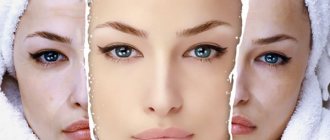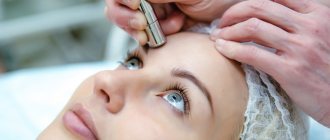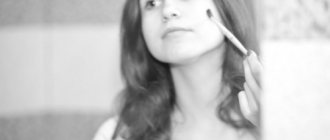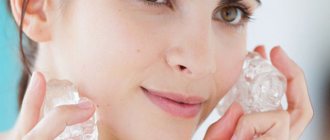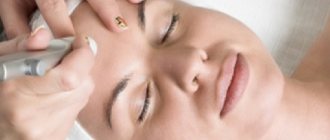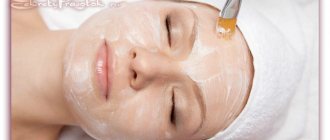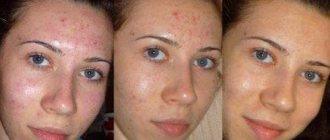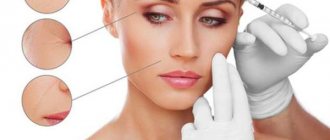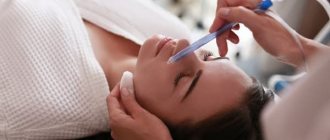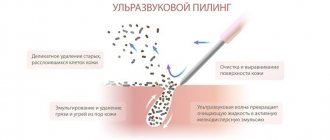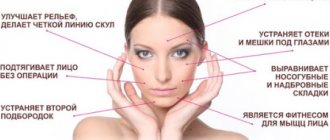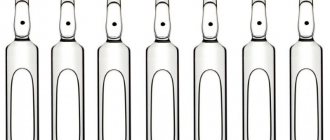If we consider the structure of our skin, we can understand that it consists of several layers, each layer has its own structure and is constantly renewed; if the deepest layers change slowly, then the cells of the upper epidermis are constantly renewed. When the skin loses its healthy and beautiful appearance, it is worth thinking about how to cleanse the surface of the face to make the appearance more attractive and the skin healthy. Superficial chemical peeling of the face provides this opportunity, and the procedure is carried out both in the salon and at home.
Superficial facial peeling differs from others in that it only removes dead skin flakes without disturbing the remaining layers, and it is the upper epidermis that is usually most susceptible to the influence of ecology and other factors. There are several types of peelings that a woman can do at home, but today we will only talk about chemical compounds that will help cleanse the skin of inflammation, pimples and blackheads.
What is superficial peeling
There are three main types of peeling procedures – superficial, medium and deep. They differ in the depth of action of the active substance, which removes dead skin cells and stimulates the growth of new ones. Superficial peeling is considered the safest among them - it does not have a strong negative effect on the epidermis and has the shortest recovery period, while when carrying out a medium or deep procedure, the skin layers take much longer to recover (from a month).
During superficial peeling, active substances act on the upper layers of the epidermis, exfoliating the layer of keratinized cells. This promotes their accelerated regeneration, fine wrinkles are removed, the natural healthy complexion is restored, the procedure becomes an active assistant in the fight against acne and other skin blemishes. There are two types of penetration depth of surface peeling:
- Shallow depth . With this peeling, the active components act exclusively on the stratum corneum of the epidermis.
- Average depth . In this case, peeling covers several layers of the skin, including affecting living cells.
How does the procedure work?
Here you will be presented with a general scheme for carrying out surface peelings. Different manufacturers may have their own characteristics and differences.
Step 1. Preparing the skin.
At this stage, the skin is washed with a mild cleanser to remove makeup and impurities from the surface of the skin. After this, the skin can be degreased using special lotions, as well as preliminary application of weak acid solutions to prepare the skin for the action of more concentrated preparations.
Typically, acid preparations used to prepare for peeling even out the depth of the epidermis and promote more uniform penetration of the peeling composition into the skin.
After degreasing, washing is usually not carried out. If a preparatory composition has been applied, its residues are washed off with water.
Step 2: Applying acid.
Acid preparations can be applied in a gentle or aggressive manner, depending on the purpose of the procedure. The gentle method involves applying the drug with a brush and quick, light touches.
The aggressive method is to apply the peeling preparation with a cotton pad or gauze pad, which is applied slowly and with pressure.
As a result, depending on the chosen method, different amounts of acid reach the skin, and, accordingly, the effect of the procedure will be different. After the required amount of time has passed, the drug is washed off with water.
Step 3. Final.
A caring mask or cream selected according to your skin type can be applied to the skin.
What else do you need to know
In order for the results and effect of the procedure not to disappoint, you need to understand where are the advertising promises and where is the real information about the capabilities and limitations of each type of peeling.
Video: Master class - peeling
Types of superficial peeling
There are four main types of surface treatment – physical, biological, chemical and mechanical peeling. All of them have their advantages and disadvantages; depending on the method, the accuracy and depth of penetration of active substances differs. More information about types of peeling:
- Mechanical . This is the simplest way to carry out a superficial procedure. A girl can do it both at home and in the salon. It consists of using products such as salt or cream based scrubs. They contain small hard particles - abrasives that gently exfoliate the skin. Mechanical peeling can be carried out in the salon using cosmetology devices, but this procedure is unpopular due to possible pain. Also, for superficial effects, special creams (gommages) are used during facial massage.
- Physical . This type of peeling is an exclusively salon procedure, as it requires professional equipment. The impact on the upper layer of the epidermis is carried out using ultrasonic and ultraviolet radiation, liquid nitrogen, carbon dioxide, and water vapor. Physical peeling also includes a procedure using a laser, which is distinguished by the precision of penetration of the active substance. In this case, different areas of the epidermis can be treated with different depths of exposure.
- Biological . For this type of procedure, cosmetologists use special substances - enzymes. The component is a protein enzyme that helps accelerate biochemical reactions, resulting in rapid skin renewal.
- Chemical . The main component of this procedure is fruit acids. When used correctly, there is no injury to the epidermis. These substances, acting on the skin, trigger natural processes of exfoliation and renewal, promoting cellular regeneration. Peeling components such as malic, tartaric, glycolic, and lactic acid are very popular. Glycolic peeling promotes collagen synthesis, has an antiseptic and antioxidant effect, helping with age-related skin changes.
Kinds
Mechanical
This procedure is called microdermabrasion. This is the removal of dead cells by physical impact on the surface of the skin in the following ways and means:
- solid particles that act as a scrub for the skin: diamond chips, apricot kernels ground into fine powder, rice or other abrasives;
- a stiff brush designed to clean leather made of soft stainless metal, seaweed or other suitable material;
- a vacuum cleaning device that creates reverse thrust and thus sucks out impurities from the pores and tears off the keratinized epithelium.
We recommend: Is it possible to do intimate peeling? Features of the procedure and technique
Hardware
It is performed using a technique that removes dead skin cells using laser, ultrasound or diamond grinding.
When hardware laser peeling is performed, an anesthetic is applied to the skin and the beam is applied to certain areas. In ultrasonic peeling, the skin is pre-treated with a moisturizer and then an ultrasonic wave is directed at it.
Chemical
During such procedures, acids and alkalis of varying concentrations are applied to the skin , depending on the properties of the products, skin type and purpose of exposure. For such peelings, products with different properties are used:
- Enzymes. These substances are not acids, but enzymes of plant or animal origin. They cleanse the skin of dead epidermis, fats and impurities, while being gentle on it, so they are suitable for sensitive skin. The following enzymes are used: papain, pepsin, lysozyme, pancreatin, travase, sorbain and others.
- Acids. The following active acids are used: trichloroacetic, azelaic, salicylic, glycolic, lactic, malic, phytic, etc. at a concentration of 10–20%.
- Combination of acids and enzymes.
Chemical peels are used more often than other types of deep cleaning because they do not require the use of special equipment, and the effect of their effects becomes obvious quickly.
Chemical superficial peels are made using such substances:
- Lactic acid . This is a gentle and hypoallergenic component that makes the complexion healthy, the tone even, and the skin elastic.
- Phenoxyglycolic acid . Almond peeling is made on its basis, because the main active ingredient is extracted from bitter almond extract. Eliminates acne and signs of skin photoaging.
- Glycolic acid. The source of this component is sugar cane. Glycolic peeling makes the surface layers of the skin permeable to beneficial substances. The skin is smoothed and its color improves.
- Salicylic acid. This substance is especially active in fighting acne.
- Retinoic acid. This peeling is called yellow peeling because after it the skin acquires a yellow tint for a day or two. This substance is effective against the first signs of skin aging, age spots, scars.
- Jessner peeling. If it is applied in one layer, it will only affect the layers of the epidermis. For the procedure, a multi-acid composition of salicylic, lactic acids and resocin is used. It has its own application features. It is prescribed for seborrhea, increased pigmentation, hypercreatosis, freckles and other pathologies.
Attention! The Jessner peel is an aggressive procedure, even if done only superficially.
Indications for the use of superficial peeling
Like any cosmetic procedure, superficial peeling has indications for use. Any girl can use it, regardless of what type of skin she has - dry, normal, oily.
Oily skin requires a course of treatments more often than normal or dry skin. A representative of the fair sex can do superficial peeling of the face once every two weeks, and of other parts of the body - once a week.
Main indications for the superficial procedure:
- problematic oily skin;
- acne treatment;
- enlarged pores;
- age-related skin defects;
- hyperpigmentation;
- seborrhea;
- acne scars.
After the procedure, noticeable differences appear almost immediately: the skin becomes smoother, more even, fine wrinkles are smoothed out, and a healthy natural tone appears. Peeling is used not only in the treatment of epidermal problems, but also as a prevention of enlarged pores and acne. However, due to the shallow depth of penetration, for a long-term positive effect from the procedure to appear, it must be repeated often. Depending on the age and condition of the client’s skin, the cosmetologist prescribes the number of peelings.
After the procedure, it is extremely important to take care of minimal exposure to irritants on the skin: solar radiation, cosmetics, mechanical damage (for example, when using an epilator). This will help her recover faster.
Execution technique
This effect on the skin is carried out in several stages:
We recommend: What is coral facial peeling, how is it done and what is the care after the procedure?
- Preparation. First, the skin is cleansed using soft foams or mousses to remove dirt and skin secretions. Then the surface to be treated is degreased with a special compound or lotion. They can also apply a gel with weak acids to prepare the skin for more intense effects.
- Application of the main active composition. There are differences in this stage of peeling depending on its type:
- If this is a chemical peel, then the active product is distributed over the skin either with light movements, which has a more gentle effect, or by rubbing it into the surface with a cotton pad to enhance the effect. The product is kept on the skin for a certain time, depending on the active substance and the condition of the skin.
- When performing mechanical peeling, an abrasive agent is applied to the face, and the skin is massaged with light circular movements of the fingers or a special brush.
- Neutralization. After removing the cleansing composition, apply a product that normalizes the acid-base balance of the skin and remove it with warm water.
- Recovery . A soothing mask is used to relieve inflammation after intense exposure or moisturizing compositions with hyaluronic acid, alginates or amino acids.
Benefits of superficial peeling
Superficial peeling has many advantages, thanks to which girls return to undergoing the procedure again and again:
- Painless . When active substances act on the upper layers of the epidermis, women do not experience any noticeable pain. A slight burning sensation may occur.
- Fast recovery period. The skin returns to its normal state within a few days, possible redness and flaking disappear, unlike peelings of deeper penetration.
- Lack of seasonality of the procedure. Surface exposure to active substances can be carried out at any time of the year. However, in summer you should avoid direct exposure to sunlight and use protective products.
- Safety. The risk of serious skin damage and burns during the procedure is minimal.
Before undergoing superficial peeling, girls need to take into account the negative consequences that may occur after the procedure: redness, dryness, flaking of the skin. These epidermal reactions are natural and usually disappear during the recovery period (one to two days). If peeling was carried out incorrectly or contraindications were not taken into account, the opposite effect of the procedure may occur - deterioration of the skin condition and increased pigmentation.
Glycolic
This type of chemical peeling can be carried out at home, but it is very important that the woman dilute the acid correctly and use a concentration suitable for her skin. This procedure affects two layers of our skin, for this reason it can be used not only as a superficial, but also as a middle type of skin cleansing. Thanks to this action, the acid helps fight serious acne, not too noticeable wrinkles, as well as various types of age spots on the face. You can note the peculiarities of this peeling, because girls often choose this product due to its low invasiveness and general availability.
Most acids have a specific effect on different skin types, for this reason women are advised to choose types of peeling according to their skin type, but Glycolic can be used for any skin.
Contraindications
Before going for a peeling procedure, you need to study a number of contraindications. If you do not take them into account, the effect of active skin renewal can be negative and cause such negative consequences as burns, increased pigmentation, exacerbation of the problem of acne and others. In what cases should you not do superficial peeling:
- Active stage of viral diseases (for example, herpes).
- Exacerbation of acne.
- Pustular rashes.
- Allergic diseases of the epidermis.
- Simultaneous use of aromatic retinoids.
- Cosmetic procedures that have a traumatic effect on the skin, which were carried out several days before peeling.
- Abrasions, cuts.
- Individual intolerance to components.
Indications and contraindications
Typically, the list of indications for any peeling includes the most common skin problems such as:
- wrinkles,
- photoaging,
- achieving skin tone,
- acne,
- acne,
- pigmentation.
Who doesn't have at least one of the above? In fact, for each problem, each skin type, at different ages, different peels will be effective.
Glycolic peeling will not have the effect expected by the client if used to remove acne and excess oil on thick, oily or combination skin.
Salicylic acid and the alcohol with which it is diluted will dry out already dry and dehydrated skin, if only the presence of acne is taken into account as an indication for peeling.
If you do peeling with fruit acids only to narrow the pores, which themselves are large due to hypersecretion of the sebaceous glands, then you should not expect a significant effect.
They are highly soluble in water, but practically insoluble in fat. Therefore, they cannot enter and accumulate in the required concentrations in the sebaceous glands. Here you need salicylic, azelaic or retinoic acids.
They also have many contraindications and they are not limited to intolerance to the components of the drug. This includes taking retinoids, a fresh tan, and diseases of the internal organs. Therefore, it is necessary to familiarize yourself with the list of contraindications for each specific peeling and take them into account in order to avoid unexpected complications.
Carrying out the procedure in the salon
Salon peeling is not a one-time procedure. The cosmetologist determines the condition of the skin and, depending on this, prescribes a course of procedures. Typically, this number includes six to ten visits to the salon. The interval between peelings is two weeks. Stages of a professional salon procedure:
- Cleansing the skin, steaming the upper layers of the epidermis to open the pores.
- Application of the active substance. The mixture can be applied with a cotton swab or a special brush; in the second case, the degree of influence of the peeling components will be lower. After five to ten minutes, the cosmetologist carefully removes the product with a napkin. When the mixture is on the face, unpleasant sensations may occur - slight tingling, burning, but this is a normal skin reaction.
- The procedure ends with the application of a nourishing cream and a light massage.
The cost of the superficial peeling procedure differs depending on the type of treatment and starts from 2,500 rubles. The average price is 2500-5000 rubles.
Post-procedure care
This is a traumatic procedure, so after it the person needs special care and protection from negative external influences. Gentle facial care will need to be carried out for about a week after peeling, and then you can return to your usual procedures and cosmetics.
What not to do after the procedure:
- After peeling, you should not touch your face because the skin is injured and inflamed. There is a risk of infection and increased inflammation.
- Immediately after the procedure, it is recommended not to wash your face for 12 hours, not to steam your face, so you should refrain from visiting a bathhouse or sauna.
- The skin should not be exposed to intense ultraviolet rays, so visiting a solarium and taking natural sunbathing in the first few days after superficial peeling are contraindicated. When going outside, you should apply sunscreen to your face.
- For a week after the procedure, you should not use scrubs or products that contain alcohol.
- If after the procedure peeling occurs and crusts form, they should not be torn off so as not to cause an infection; this can also injure the skin and cause scarring. In this case, the use of scrubs is also contraindicated: they will not speed up the exfoliation of the epidermis, and can further injure the skin.
- For the first time after peeling, you should avoid using decorative cosmetics: foundation, blush and powder. They can increase inflammation and clog open pores and prevent the skin cleansing process from being completed.
Important! Oils should not be used to remove peeling, although this seems to be a suitable remedy. Fats will seal the pores and prevent epidermal cells from exfoliating, since this process occurs not only during the peeling procedure, but also after it.
In the first days after such cleansing of the skin, it is recommended to use:
We recommend: What is a medium facial peel? How is the procedure performed and are there any contraindications?
- light moisturizing and softening compositions for washing and soft purified water;
- skin cleansers based on thermal or micellar water;
- preparations that contain panthenol, retinol and bisabolol in order to relieve inflammation and speed up recovery;
- non-greasy nourishing or moisturizing creams, gels and fluids with a light texture;
- products with vitamins B5 and B3, which help restore the skin.
Superficial peeling performed by a cosmetologist will not only cleanse the skin, but also launch its restoration processes, which will reduce the signs of aging and make it look fresh and healthy.
Superficial peeling at home
At home, a woman can perform a mechanical type of peeling. It uses scrubs bought in a store, or homemade recipes, gommages. To carry out the procedure, you need to cleanse the skin, apply the required amount of scrub, gently massage your face, and then rinse with water. Gommage, a special mask, is distributed over the surface of the epidermis and is removed after some time along with the dead cells. After this, nutritional and caring procedures are carried out.
Cosmetics for superficial peeling
In a pharmacy or cosmetic store, a representative of the fair sex can find ready-made peeling products that will help renew the skin and improve the structure of its surface. These are special masks, scrubs, creams, preparations with fruit acids. The most popular among them are the following:
- Jessner peeling. Contains lactic acid, salicylic acid, resorcinol. To peel, you need to apply one layer of the product and wash it off after five to ten minutes.
- Coffee and honey scrub “Green Pharmacy” for normal skin. Contains a cream base and apricot kernels. Helps gently exfoliate the stratum corneum of the epidermis. After a light massage (after 1-2 minutes), rinse off.
- Peeling cream “New line” with fruit acids. Contains glycolic and lactic acids, betaine, allantoin, soybean oil. Directions for use: Apply to skin, massage gently for 2 minutes and rinse with water.
Homemade peeling recipes
Homemade recipes will help women create their own superficial peeling product. It is necessary to select components depending on the skin type in order to ensure the best effect of the procedure on the epidermis. Options for preparing the peeling product:
- Salt peeling for oily skin. Mix a tablespoon of cream with a teaspoon of table salt. Apply the mixture to your face and wash off after twenty minutes.
- Glycolic recipe for dry skin. Mix yogurt with white sugar one to one and apply to face. Wash off after twenty minutes.
- Oatmeal for normal skin. Add a little water to a handful of ground oatmeal and apply it to your face. Massage lightly for a couple of minutes and rinse.
What types of peelings are there, and who are they indicated for?
As already mentioned, superficial chemical peeling of the face has a number of advantages, since it can only remove remnants of the epidermis that have not yet been eliminated from the skin on their own, and it is because of the keratinized particles that the process of inflammation and other skin problems occurs.
If a girl can cleanse her face in time, the cells will begin to gradually renew, the skin will be saturated with oxygen, and all harmful bacteria will be eliminated, which will make it easy to eliminate troubles such as pimples, blackheads, blackheads, as well as greasiness and oily shine.
Usually cosmetologists classify all peelings according to the main active component included in its composition, but only an experienced cosmetologist can determine which peeling option is best to choose. Each substance can combat different problems, and for each skin type it is necessary to select a specific chemical so as not to cause harm. Chemical peeling is very common; at home, fruit pulp or various acids are most often used, but also in salons, girls are offered hardware cleaning using a special powder made from chemical reagents. Below we will look at the main types of chemical peels.
Superficial peeling – before and after photos
The effectiveness of superficial peeling is shown by reviews from many girls who visited this procedure in a salon or did it at home on their own. But the main proof of its effectiveness are photographs of women who have undergone a course of health-improving measures using peeling agents. See photos before and after the procedure:
Choosing a treatment method according to skin type ↑
For a cosmetologist, the main indicator for choosing the type of treatment is skin type. There are four main ones.
- Age up to 30 years. No visible wrinkles. The procedure is carried out to prevent aging of the facial skin. Superficial peeling should be done once a year with three sessions.
- Age 25-35 years. Small wrinkles in the corners of the eyes in a relaxed state of the face, slight pigmentation. It is recommended to carry out superficial peeling twice a year for 4-6 sessions.
- Age 35-50 years. Pronounced shallow wrinkles around the eyes, mouth, forehead, age spots. A superficial type of procedure should be carried out regularly at intervals of 20 days. It is worth discussing with your doctor the possibility of performing a medium peel.
- Mature age. The whole face is covered with deep wrinkles, the pigmentation of the skin is impaired. It is worth attending three sessions of the middle type of procedure, then regularly peeling with glycolic acid.
Today, chemical peeling is the most popular salon procedure.
The best results from exposure to acids are noticeable in people with skin types 2 and 3. But with regular use and correct calculation of the required concentration, patients with skin type 4 will see a significant difference before and after chemical peeling.
You need to take care of your health and appearance, and not “indulge” in self-medication. You cannot choose your own chemical peeling products. Only a doctor can determine the appropriate type of procedure and calculate the required proportions of the solution components.
Types of chemical peeling
Depending on the degree of penetration of the acid into the skin, cleaning is divided into types:
- superficial
- median
- deep
Superficial peeling is also called chemical facial cleansing. It is recommended for people under thirty years of age to improve metabolism, whiten skin, and also to combat acne. Fruit acids are used for cleansing. This is the most gentle type of cleaning. The effect is achieved by completing the full course, which consists of several procedures at intervals of up to fifteen days.
Medium peeling can fight age spots and wrinkles. It is carried out using salicylic acid, which affects the middle layers of the epidermis of the skin. This painful procedure gives an amazing rejuvenating effect: the skin looks ten to fifteen years younger. The full course consists of several sessions, spaced at intervals of ten days.
Deep peeling is carried out using phenol. This makes it possible to penetrate into the deep layers of the epidermis, which helps in the process of smoothing out wrinkles, as well as getting rid of age spots. This very painful procedure is performed only in a hospital, under the constant supervision of a doctor. The effect is simply amazing - the skin not only looks younger, but also retains its fresh appearance for a long time.
